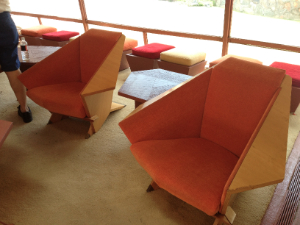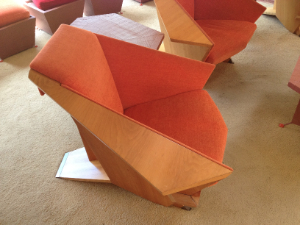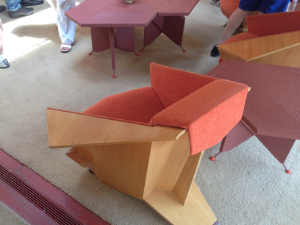This article is reprinted with permission, with minor modifications, from The Ergonomics Report™, where it originally appeared on November 2, 2005.
Aesthetics + innovation + ergonomics = timeless design. This simple proven formula for creating a classic office chair doesn’t hold up when applied to lounge seating. In fact, living room chairs and sofas may achieve iconic status regardless of their ergonomic qualities.
The icons look as if they were designed today, but some are over 80 years old. And all suit open-plan living, a concept of architectural design that remains as popular today as when Frank Lloyd Wright et al introduced it in the 1920s.
Without exception, they are sculptural statements, works of art, and most are still in production. Knoll,Inc., Herman Miller, Steelcase and Vitra AG are among the manufacturers around the world that have commissioned chairs now regarded as icons. Many other companies produce them under license.
Harry Bertoia’s 1952 Bird high-back chair, sculpted from bent metal rods, pushed technological experimentation to the limit. Art for art’s sake also found a place. UP 5 (Donna) chair, designed in 1969 by Gaetano Pesce, was shipped from C&B Italia compressed and vacuum-packed in a PVC wrapper. When opened the chair expanded, creating an "art happening."
The Barcelona Chair, designed by Ludwig Mies Van der Rohe in 1929 is regarded as an artistic symbol of its era, a statement of the Bahaus design school that sought to make household items functional and elegant. An original sits in New York’s Museum of Modern Art. According to the museum, the Barcelona Chair helped pioneer ergonomics.
The Ergonomics Report™ asked a Knoll spokesman, who didn’t wish to be named, about the ergonomics of the icons his company manufactures. He pointed to the Womb Chair designed by Eero Saarinen. "When Florence Knoll asked him to make that chair, she didn’t have that form in mind. … She said she wanted a chair that felt like a basket of pillows, and something she could curl up in." Qualities of comfort and support were essential to the development of that particular product, he explained.
A chaise lounge designed by Le Corbusier, Pierre Jeanneret, and Charlotte Periand in 1928 has a moveable seat and adjustable headrest, and is regarded as one of the earliest examples of ergonomic design.
The comfort, support and adjustability built into the design of office chairs can’t be counted on in the classics of informal seating, but also can’t be counted out. The Knoll spokesman and other experts interviewed by The Ergonomics Report™ credit the designers with varying degrees of know how.
"The qualities of comfort and support are ones I think all of our products have possessed, including the ‘object furniture’ produced by Knoll Studio," the spokesman explained.
Herman Miller makes George Nelson's Marshmallow Sofa (1956) and Eames lounge chairs Model nos. 670 and 671 among many other classics. Asked about these designers’ approach to ergonomics, company spokesman Mark Schurman explained that Nelson and Eames were students of the human form and its interaction with seating. "Eames, in particular, worked through a very iterative process and sought to create unmatched comfort – an outcome of good ergonomics – while exploring new materials and forms." He said he didn’t know if the two were explicitly studying ergonomic principles or using demographic data but did experiment with prototypes and people's experience with their designs, generally from within the staffs of their design studios. "Certainly they were very concerned with issues like fit, support, comfort and, to a lesser degree, adjustability." He pointed out that the adjustable elements were limited in some chairs, but explained it as an issue of available technology.
Joe Kunkel, an expert in vintage modernist home furnishings at the Jet Set Modern company in Chicago, credited the iconic designers with considerable ergonomic know-how. "(It) was very much considered an integral part of the modernist design movement, not only visual style and use of materials." Charles Eames and his wife, Ray, "… created innovative designs in the post-WWII era, notably with the developed of bent plywood and ergonomic designs which contour the human body for fit and comfort using simple, affordable materials. Their work stemmed in part from a government project in which they formed plywood leg splints during the war." Harry Bertoia, George Nelson, Eero Saarinen also incorporated ergonomic design in their work, he said.
Professor Paul Eshelman, who teaches interior and furniture design at Cornell University at Ithica, New York, sees minimal concern with ergonomics in the designers’ approach. He describes the classics as explorations in form, composition and, to varying degrees, applications of innovative thinking about manufacturing technologies. "Fit to human form was more likely an artistic interpretation than an ergonomic application. … They are recognized … not because of their ergonomic performance, but instead because of their aesthetic or technological innovation."
They gathered anthropometric information in an ad hoc manner, taking the measurements of a random selection of people, according to Professor Eshelman. "It was not until Niels Diffrient, Alvin Tilley, and Joan Bardagjy, working for Henry Dreyfuss Associates, compiled the Humanscale guides in 1974 that ergonomics broadly found its way into furniture manufactured in the United States. … These guides were preceded and motivated by the German DIN standards (Deutsches Institut für Normung, the national organization for standardization). "The first seating product on the United States market designed specifically based on ergonomic information was the Ergon Chair by William Stumpf, 1973."
Ergonomics By Default?
A designer who knew Charles and Ray Eames and who worked over the years alongside William Stumpf at Herman Miller is skeptical about the role of ergonomics in the design of classic lounge chairs. Jack Kelley, principal of Studio 222 in Grand Haven, Michigan, formerly a lead designer at Herman Miller, doubts that Charles Eames knew what ergonomics was all about, but acknowledges the informal expression of its principles. "His awareness about that particular term and what it means today are two different things … but he (worked) to make things basically beautiful in two segments. One is to aesthetics, the visual aspects, and also the comfort factor. And the beauty of his chairs survived, no matter what happens, and there is no ergonomic relationship there at all, other than it is very comfortable."
The Eames company website, Eamesoffice.com, on the other hand, emphasizes the couple’s ergonomics expertise. "The conceptual backbone of this diverse work was the search for seat and back forms that comfortably support the human body, using three dimensionally shaped surfaces or flexible materials instead of cushioned upholstery. An ethos of functionalism informed all of their furniture designs." Ray Eames is quoted as saying, "What works is better than what looks good. The looks good can change, but what works, works."
Expression, not ergonomics, was paramount, according to Professor Eshelman. He said new technology was what really stirred Eames. "It was an incredible balance between what was new in terms of … the plywood molded elements, and also this new material called fibreglass, which he created his armchairs out of. He and Eero Saarinen … both experimented in this, you might say, media, which gave them an opportunity to express themselves like no other designers have in the past."
Flawed Icons
Chairs can reach iconic status regardless of their ergonomics. Professor Eshelman says there are plenty of examples of classic chairs that fail on ergonomic grounds, and the Wassily chair by Marcel Breuer, designed in 1925, tops his list. "I’ve seen it for years. I think it is one of those enduring designs that frequently appears in contemporary designs, architect designed homes, interior designed spaces, and from an ergonomic point of view, when you sit into it, because of the angle of the seat and the height of the chair, you kind of slide to the back of it." He also faults it for limiting social interaction. "It is quite often used in tandem," he explained, "and if you were to use it in any kind of social context, the chair literally fixes you in one front-facing orientation. It isn’t a design that has any latitude for sitting a bit sideways, so you can converse. Or it just forces you into this front-facing orientation. So it’s a work of art, more sculptural than it is supportive of any social agenda."
He has doubts about the ergonomics of one of the most renowned Eames designs. "His 670 Lounge chair … looks very comfortable and is a wonderful seating experience. But if you are taller, the cushions don’t hit you quite right. And it certainly isn’t a chair that the elderly can get in and out of."
Mark Goetz, furniture designer and professor of design at Pratt Institute in Brooklyn, New York, recently ranked several of the classics for ergonomic qualities in an article published by Departures.com. Two famous chairs don’t pass his comfort test. His review of the Wassily Chair rounds out Professor Eshelman’s assessment. Professor Goetz describes it as "a half-hour chair—sit in it any longer and it's uncomfortable." The Barcelona Chair is one of the greatest chairs of the twentieth century, but it was "not meant to be sat in for long periods of time. The concave back is hard on the spine."
Asked about the potential of the bentwood chair designed recently for Knoll by famed Canadian-American architect Frank Gehry, the spokesman agreed it could become a classic. The creation of looping laminated maple strips called the Cross Check™ chair is comfortable to sit it, he says, but he doesn’t see that as Gehry’s main objective. "It was more a study in form and how to support weight in a very innovative way, with these thin strips of wood laminated together. … Achieving a chair that is ergonomically sound was not the primary objective, but it certainly was a by-product, and it is certainly is a comfortable and supportive chair."
In varying degrees, the same could be said for the older classics. The conclusion? Ergonomics was a by-product, not an essential element in the equation that determines posterity.
December 14, 2012 Update
I recently visited Taliesin West, now a National Historic Landmark in Scottsdale, Arizona, where Frank Lloyd Wright spent winters later in his life. Here are a few pictures of one of his chairs. The story goes that this was a room where he and his wife entertained guests. His intention was that his guests would mix and not sit or stay too long. Not shown in this picture are the chairs he and his wife sat in while they lounged in this room, which appeared to be much more comfortable, overstuffed style leather, if I recall correctly. Peter Budnick



Sources: Professor Paul Eshelman; Jack Kelley; Joe Kunkel; Knoll,Inc., Herman Miller, Departures.com.
